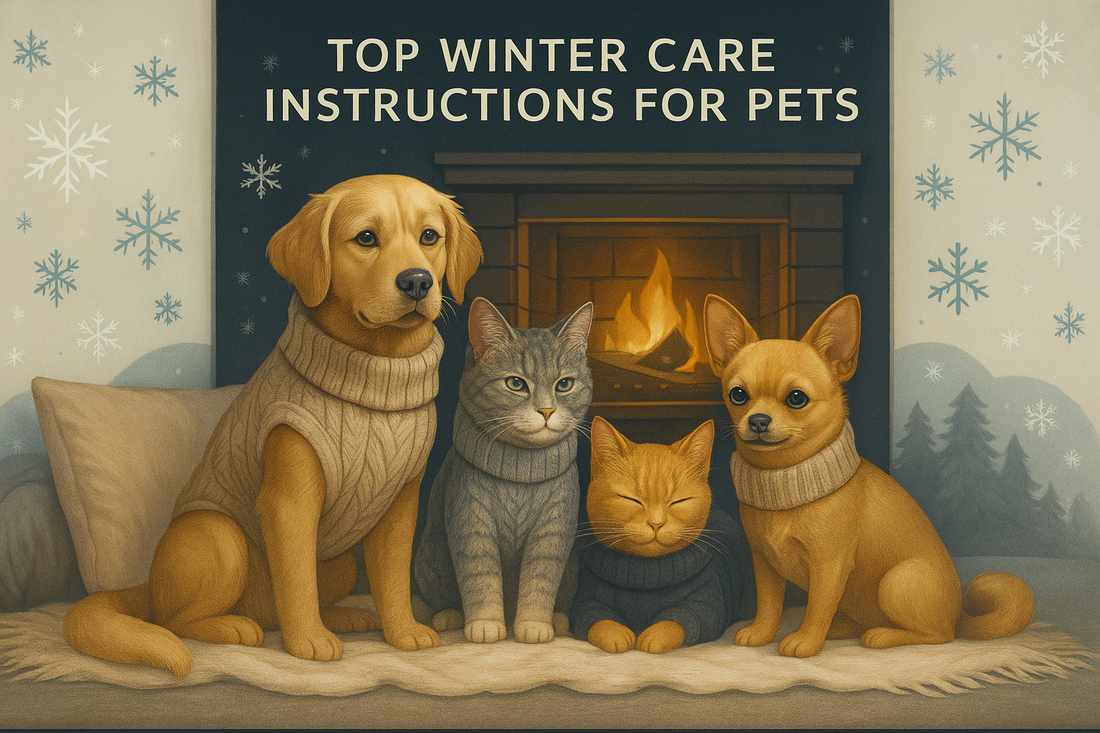
Stay Cozy: Top Winter Care Instructions for Pets
Stay Cozy: A Veterinary-Formulated Guide to Advanced Winter Care for Your Pets
Evidence-Based Protocols for Thermoregulation, Safety, and Wellness in the Cold European Climate
Executive Summary: The winter season presents a unique set of physiological and environmental challenges for companion animals. Beyond the anecdotal "put a coat on your dog," this guide delves into the veterinary science of thermoregulation, the toxicology of common winter hazards, and advanced behavioral enrichment strategies to ensure your pet not only survives but thrives during the colder months. Implement these professional protocols to safeguard your pet's health.

🔬 The Canine & Feline Thermoregulatory System: A Scientific Foundation ▶
Understanding how your pet maintains its core body temperature is critical to preventing hypothermia and frostbite. Unlike humans, who sweat uniformly, dogs and cats primarily rely on:
- Vasoconstriction: The narrowing of blood vessels in the skin and extremities (ears, paws, tail) to reduce heat loss and preserve core warmth.
- Pilorection: The fluffing of fur to trap a layer of insulating air close to the skin. This is less effective in wet conditions.
- Shivering Thermogenesis: Involuntary muscle contractions to generate heat.
- Non-Shivering Thermogenesis: Increased metabolic rate in brown adipose tissue (more common in neonates).
Sighthounds (Greyhounds, Whippets): Possess a higher surface-area-to-volume ratio and lower body fat, leading to rapid heat dissipation.
Arctic Breeds (Huskies, Malamutes): Their dense double-coats are highly efficient, making them prone to overheating indoors if the thermostat is too high.
Toy Breeds & Seniors: Often have less muscle mass and a less robust metabolic rate, compromising their ability to generate heat.
⚠️ Critical Winter Hazards: Advanced Risk Mitigation Protocols ▶
1. Antifreeze (Ethylene Glycol) Poisoning
This is a veterinary emergency. Its sweet taste is attractive to pets. Ingestion causes rapid metabolic acidosis and acute kidney failure, often fatal without immediate treatment.
Pro-Tip: Use propylene glycol-based antifreeze, which is less toxic. Immediately clean any spills with an absorbent material and store containers in sealed, inaccessible cabinets.
2. Ice Melt Chemical Exposure
Salts and ice melts can cause chemical burns to paw pads, and ingestion from licking paws leads to oral irritation and gastrointestinal upset. Some are more toxic than others.
Pro-Tip: Wipe your pet's paws, legs, and belly with a warm, damp cloth immediately upon returning indoors. Use pet-safe ice melts on your own property.
3. Hypothermia: Clinical Recognition
Core body temperature drops below 37°C (99°F). Stages: Mild (32-37°C): Strong shivering, lethargy. Moderate (28-32°C): Muscle stiffness, confusion, shallow breathing. Severe (<28°C): Shivering stops, dilated pupils, coma.
Pro-Tip: Rewarm gradually. Use warm (not hot) blankets and heating pads on a low setting wrapped in a towel. Avoid rapid rewarming which can cause dangerous circulatory changes. Seek immediate veterinary care.
🐾 Paw & Coat Integrity: Professional Grooming and Protection Strategies ▶
Your pet's first line of defense is their integumentary system (skin and coat). Winter demands a proactive approach.
- Paw Pad Care: Ice balls can form between toes, and sharp ice can lacerate pads. Apply a pet-specific paw wax (e.g., Musher's Secret) before walks to create a protective barrier.
- Coat Maintenance: Do not shave your dog down to the skin in winter. A longer coat provides insulation. However, regular brushing is crucial to prevent matting, as matted fur loses its insulating properties.
- Post-Walk Decontamination: Thoroughly dry your pet, paying special attention to the paws, legs, and underside.
Place the back of your hand on the pavement/ground. If you cannot hold it there comfortably for 15 seconds, it is too cold for your dog's bare paws. This simple test prevents frostbite on contact.
🧠 Nutritional & Behavioral Enrichment: Combating "Confinement Frustration" ▶
Reduced outdoor activity does not mean reduced mental stimulation. A bored pet is a destructive pet.
Nutritional AdjustmentsIndoor pets may require fewer calories to avoid weight gain. Conversely, highly active outdoor working dogs may need a slight caloric increase. Consult your veterinarian for a precise plan.
Pro-Tip: Ensure a constant supply of fresh, unfrozen water. Heated water bowls are an excellent investment to prevent freezing outdoors.
Cognitive Enrichment Protocols
- Food Puzzles & Snuffle Mats: Engage natural foraging instincts and provide mental exercise.
- Clicker Training: Teach new, complex tricks indoors. This strengthens your bond and provides cognitive challenge.
- Novel Indoor Obstacle Courses: Use pillows, boxes, and furniture to create a safe agility course.
- Controlled Socialization: Arrange indoor playdates with compatible pets to maintain social skills.
🚗 Special Populations & Scenarios: Geriatric, Arthritic, and Automotive Safety ▶
Geriatric & Arthritic Pets
Cold weather exacerbates joint stiffness and pain from arthritis. Provide:
- Orthopedic, heated beds placed away from drafts.
- Non-slip rugs on hardwood and tile floors to aid mobility.
- Gentle, shorter walks, and consider physical therapy exercises approved by your vet.
- Ramps to help them access furniture or vehicles instead of jumping.
Automotive Dangers
Never leave a pet unattended in a vehicle in cold weather. A car can act as a refrigerator, rapidly holding in the cold and causing hypothermia.
Pro-Tip: The Engine Block Hazard. Outdoor and feral cats often seek warmth by climbing onto car engines or sleeping under wheel wells. Before starting your engine, knock loudly on the hood or honk the horn to scare away any hidden animals.
Synthesized Action Plan for European Pet Owners
By integrating these evidence-based winter care instructions for pets, you transform from a pet owner into a proactive guardian of their well-being. Prioritize thermoregulation, mitigate environmental toxins, and commit to indoor enrichment. Your informed actions ensure your beloved companion remains happy, healthy, and safe throughout the winter season.
highly recommended pet accessories
Disclaimer: This article is for informational purposes and does not replace professional veterinary advice. Always consult your veterinarian for health concerns and personalized recommendations.




